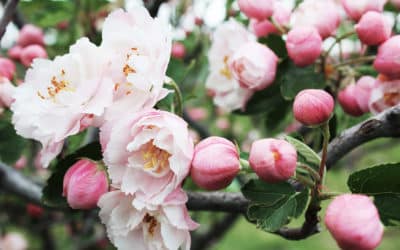Blog Topics
Customers often ask for recommendations for fast-growing trees that grow well in northern Virginia. Not all trees that grow quickly are good choices for home landscapes. Generally, the faster a tree grows, the weaker the wood will be, making the tree prone to wind and storm damage and shortening its lifespan. But there are some trees that grow quickly and still look good, stay healthy, and provide a multitude of benefits for northern Virginia homeowners. Keep reading for our top recommendations that will give you a fully-grown tree sooner rather than later.
Why Choose a Fast-Growing Tree?
Fast-growing trees are great for privacy (the perfect natural barrier), blocking line of sight (an unwanted road or power line), and can even function as a windbreak. A beautiful fast-growing tree can help fill a large space quickly and may even increase property value. As an added bonus, the trees we suggest below also have unique ornamental value.
4 Best Fast-Growing Trees
Green Giant’ Arborvitae (Thuja standishii x plicata ‘Green Giant’)
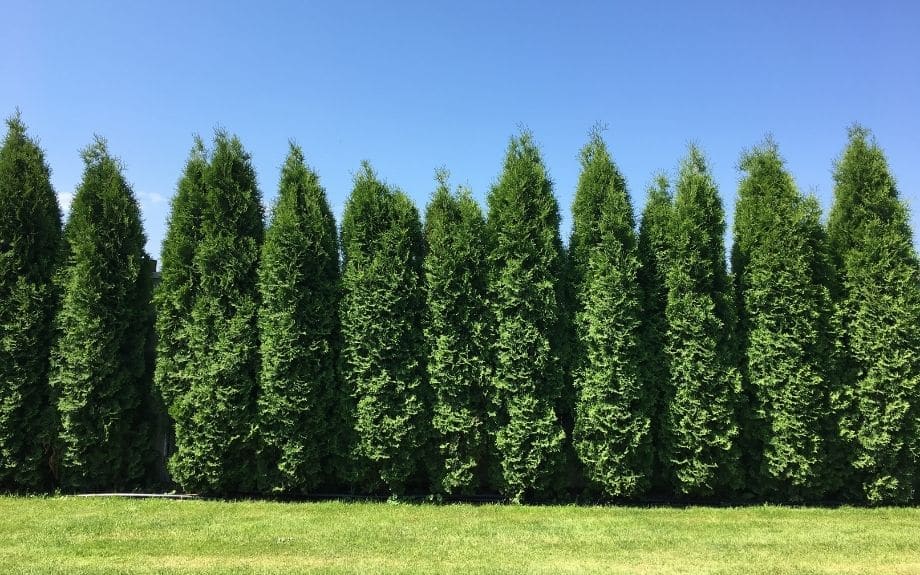
Height: 30-60 ft
Width: 10-20 ft
Sun: Full sun to partial shade
Planting Requirements: The Green Giant is large! Don’t plant it under power lines, soffits, or any place that may limit its growth. It is sensitive to salt but otherwise grows in almost any type of soil. It favors moist soil conditions so will do best with regular irrigation and a protective layer of mulch.
This is an exceptional landscape tree for use as a screen, hedge, or single specimen. Reaching heights of up to 60 feet, this evergreen grows very quickly, adding up to 3 feet to its height annually until maturity. It typically lives 40 to 60 years in the home landscape if well cared for.
A cross between the Western Redcedar and Japanese arborvitae, Green Giant has dense, rich green foliage and branches that start near ground level. It naturally maintains its column-like pyramidal shape and so needs only minimal pruning when grown as a single specimen tree.
The low-growing, evergreen foliage makes Green Giant a good choice for large hedges and windbreaks. Younger plants can be trimmed into hedges or privacy screens but will need to be trimmed once or twice a year to maintain their shape. We don’t recommend hard pruning on older plants as foliage won’t grow if you cut back to older branches.
The Green Giant arborvitae is resistant to many pests and insects and makes an excellent, disease-free substitute for Leland cypress. It is also resistant to the wind once established and can withstand heavy ice or snow, making it a good choice for a natural windbreak.
Depending on your needs, arborvitae can be planted in different ways –
- Need privacy? Plant the Green Giant 5-6 feet apart in a single row to create a natural living fence.
- Noisy neighborhood? Plant the trees in two staggered rows (with roughly 10 feet between the two rows) to block out unwanted noise.
PRO TIP: Arborvitae are sensitive to salt. Avoid planting near a driveway or road as salt spray damage may be an issue.
Cryptomeria (Cryptomeria japonica)
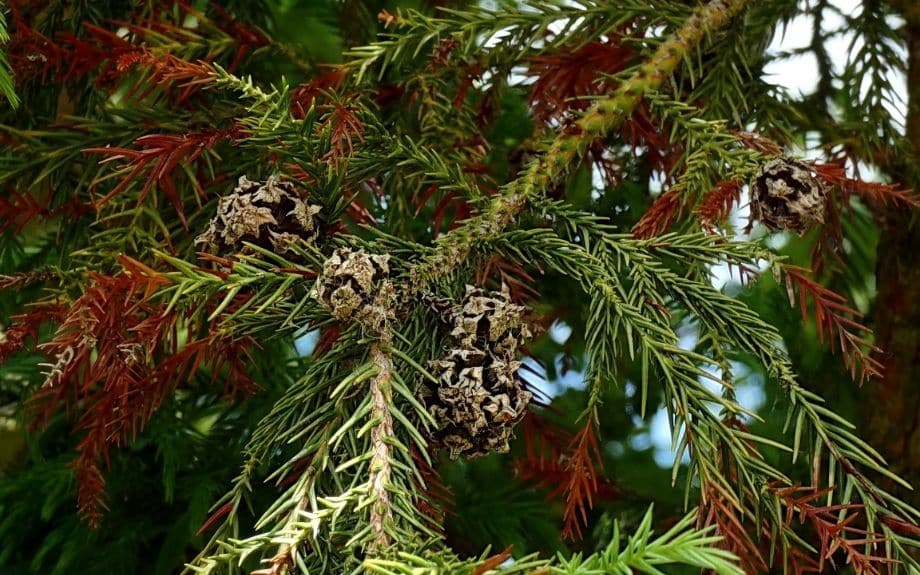
Height: 50-60 feet
Width: 20-30 feet
Life Span: 60-100+ years
Sun: Full sun to partial shade
Planting Requirements: Cryptomeria requires well-drained acidic soil and a sheltered location (it does not thrive in dry, windy locations). It’s intolerant of urban pollution.
Also known as Japanese cedar or Japanese redwood, cryptomeria grows up to 2 to 3 feet per year. While it can grow up to 60 feet tall in northern Virginia, in its native Japan (where it’s the country’s national tree), it grows up to 230 feet.
It has soft, bluish-green foliage and a stunning reddish-brown bark that peels off in strips over the years, giving the trunk a shaggy look. The Japanese call this cedar Sugi or ‘hair tree’ given its fine foliage and refined characteristics.
Cryptomeria grows in a large natural pyramidal form and requires little maintenance or pruning. If well-cared-for, these cedars can live 60 to 100 years or more.
During cold winters, the needles will turn bronze but will recover their green color in spring.
This is a spectacular tree that functions best as a landscape feature rather than a hedge. If needed, the bottom branches can be strategically pruned to allow people to walk underneath.
PRO TIP: Japanese cedars can cause allergic reactions in some people. The plant itself may cause skin irritation so wear gloves when handling it. And, because the plant is wind-pollenated, it may contribute to seasonal allergies.
‘Yoshino’ is a popular cultivar of Japanese cedar, and it grows to about 30-40 feet tall.
American Holly (Ilex opaca)
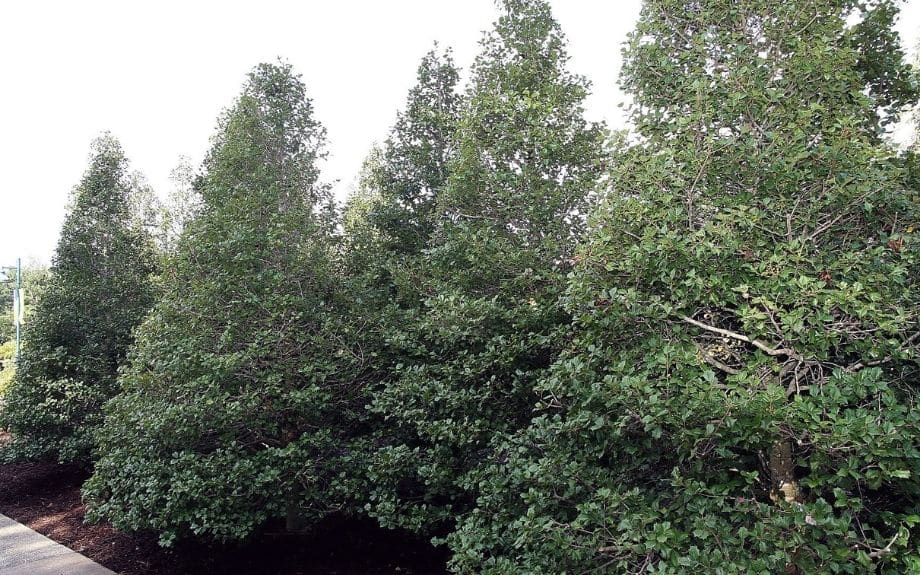
Height: 15-40 ft
Width: 10-20 ft
Sun: Full sun to partial shade
Planting Requirements: Protect hollies from winter wind (they’re prone to winter desiccation/winterburn). It grows best in well-drained, acidic soil.
American holly is native to Virginia. It can grow up to 30 feet tall in cultivation but has been found up to 40 feet tall in the wild, usually in moist forests or close to swamps. Growing 12 to 24 inches a year, this shrubby tree will quickly fill an empty space in your landscape.
American holly maintains the traditional look of holly, with deep green, thick, spiny leaves, and bright red berries. It is the quintessential Christmas holly and is perfect for holiday decoration (although its leaves are less shiny than some of the other kinds of holly). This holly is evergreen, keeping its green foliage year-round and providing excellent color for winter landscapes. The berries are a wonderful winter food source for birds.
PRO TIP: The berries will only grow on pollinated female trees. You’ll need to plant both male and female holly trees to ensure red berries.
Several other kinds of holly are native to Virginia, including one that grows even more quickly, although it’s not quite as large as American holly.
- Inkberry (glabra) – Grows 6 to 10 feet tall, 6-12 feet wide, with blackberries, a slow growth rate, produces suckers
- Yaupon (vomitoria) – Grows 12-25 feet high, has red berries, leaves and twigs can make an edible caffeinated tea, grows 2-3 feet a year https://www.lewisginter.org/yaupon-holly/
- Common winterberry ( verticillate) – Grows 3-12 feet tall and wide, red berries, grows less than 12” a year
Virginia Pine (Pinus virginiana)
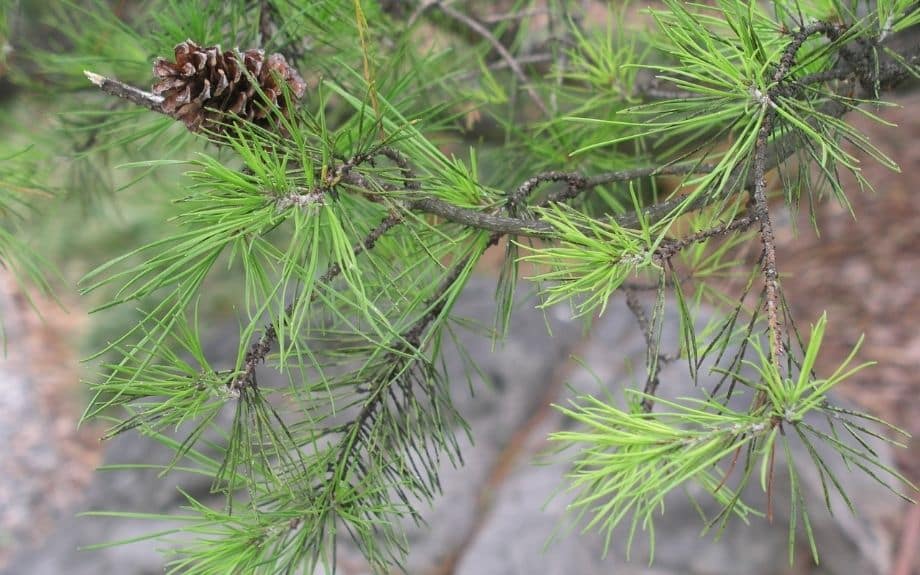
Height: 25-40 feet, can grow to 70 feet in the wild
Width: Trunk can reach 20 inches in diameter
Sun: thrives in full sun
Planting Requirements: Tolerates a range of soils conditions, including poor dry soils, but prefers well-drained, sandy, acidic loam. Can grow in soil that’s too rocky or dry for other pine trees.
Virginia pine trees have unique, twisting yellow to dark green needles, usually found in bunches of two. The tree trunk is deep cinnamon and beautiful spiny scaled cones hang from its boughs.
The Virginia pine is shorter than other types of pine trees, growing to about 30 feet in cultivated areas (although it has been found up to 70 feet tall in the wild). It will grow about a foot each year until it reaches its full height.
Once established, these pine trees can do well even during times of drought. Its lifespan is shorter than other pines, somewhere between 60-90 years on average, although it’s been known to live up to 150 years in the wild.
The Virginia pine is easily recognized by its irregular form – the limbs grow in all directions. The tree often looks like an overgrown shrub, with heavy branches all the way to the ground. This can be good for privacy but it’s a look that doesn’t appeal to everyone. It doesn’t need pruning but can be shaped if desired and the lower limbs can be removed for clearance.
There are no serious pests or diseases associated with the Virginia pine and it’s even deer resistant.
Virginia pines have both pollen cones and seed cones. The pollen cones are less than an inch long, circular, and reddish-brown to yellow. The seed cones (or pinecones) can last on the tree for up to 5 years. They are 2-3 inches long, reddish-brown, and are characterized by their sharp points.
Because the Virginia pine is a resilient, fast-growing tree, it’s a popular and natural Christmas tree choice. These irregularly shaped trees are often pruned and shaped into a more traditional pyramidal shape for the holiday season. In the home landscape, they can be left as-is for a more natural, open-branched look.
There are many pine trees that thrive in northern Virginia. They vary in shape, size, and growth rate so if the Virginia pine isn’t for you, one of these may be:
- Eastern white pine
- Pitch pine
- Red pine
- Shortleaf pine
- Table-Mountain pine
- Longleaf pine
- Loblolly pine
Let the Riverbend Team Help You!
Virginia is home to a variety of fast-growing trees, and we are happy to help you make the right selection for your space. Our team of tree care professionals will help you find a tree to suit your property, soil, needs, and preference. We’ll even plant the tree for you!
If you have questions or would like to consult with an arborist about what would best suit your property, contact Riverbend Landscapes and Tree Service today!
Learn more about our tree planting and landscaping services.
Give Us a Call at 703-402-9366
If you'd like help with your trees or landscape, have any questions, or would like to schedule an appointment with one of our Certified Arborists, please give us a call. We'd love to hear from you!

